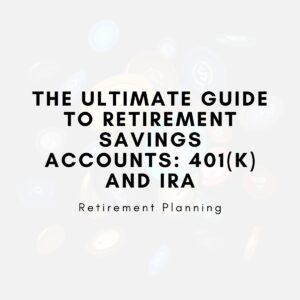
How early should you start saving for retirement?
The earlier you start, the better the outcome. Starting early with retirement planning maximizes compounding interest, leverages tax-advantaged accounts, and creates a long-term savings strategy that ensures a comfortable retirement. In this post, we’ll explore why early planning is crucial and how small, consistent contributions can lead to significant financial gains down the road.
Summary Table: The Power of Starting Early: Why Retirement Planning Matters?
| Section | Summary | Key Tips | Examples |
|---|---|---|---|
| Why Starting Early Makes a Big Difference? | Starting early allows your investments to grow exponentially with compounding. The earlier you start, the less you need to save. | Begin saving early, and take advantage of compounding growth. Even small contributions have a big impact over time. | Emily saved $300 monthly from 25 and accumulated $200,000 by age 45, while Tom had to save $500 monthly to reach the same amount at age 65. |
| The Benefits of Retirement Accounts | 401(k)s and IRAs offer tax benefits that accelerate your savings. You can grow wealth without paying taxes on the investment gains until withdrawal. | Use 401(k)s and IRAs to maximize retirement savings, and take advantage of employer contributions. | John used his 401(k) with employer matching to grow his retirement fund by an additional $2,400 annually. |
| Psychological Benefits of Starting Early | Starting early reduces stress by preventing the need for aggressive saving later in life. It also provides peace of mind. | Consistency and early action relieve financial pressure in later years. | Olivia began saving at 25, avoiding the stress that Eric faced when he started saving at 40. |
| The Power of Consistency | Regular contributions, even if small, can accumulate into significant savings over time. Automatic transfers help you stay on track. | Automate contributions and gradually increase them with your income. | David set up automatic deductions from his paycheck, building his retirement fund effortlessly over time. |
| Investment Strategies for Young Savers | Younger investors should take advantage of their time horizon by being more aggressive with stock investments. | Focus on growth assets like stocks and gradually diversify as you get older. | Sophia invested 80% in stocks and 20% in bonds at age 25, achieving substantial growth by age 45. |
This table provides a concise overview of the key points from the article on why early retirement planning is crucial. It highlights the importance of compounding, tax benefits from retirement accounts, and the psychological advantages of starting early. With practical examples, the table demonstrates how early action and consistency in saving can help individuals secure a comfortable retirement.
Introduction
When you’re young, retirement might seem far off, but getting a jumpstart on your retirement savings can have a significant impact on your future financial security. By planning early, you give your money more time to grow through compound interest, tax-deferred investments, and the advantage of contributing smaller amounts compared to playing catch-up later. This guide will discuss the many reasons why starting early is essential, and provide practical steps to help you plan for a comfortable retirement.
Why Starting Early Makes a Big Difference?
Starting your retirement savings early helps you take advantage of compound growth, potentially leading to a larger retirement nest egg with less effort. The more time your investments have to grow, the less you’ll need to save each year.
The Power of Compounding Returns
Compounding interest is the concept of earning interest on your initial investment, as well as on the interest that’s already been added to it. The earlier you start saving, the more time your money has to grow exponentially.
Example:
Let’s say you start saving $200 a month at age 25 in an investment account with a 7% annual return. By age 65, you would have around $450,000. If you wait until 35 to start, you would have to save approximately $400 a month to reach the same balance. Compounding makes a huge difference over time.
The Less You Save, the More You Gain by Starting Early
The earlier you start, the smaller your monthly contributions need to be to reach your retirement goal. By starting early, you can take advantage of market growth rather than relying on aggressive saving later.
Example:
Emily started saving $300 a month for retirement at age 25. By 45, she had accumulated about $200,000. Tom, who started saving at 35, had to save $500 per month to reach the same goal by age 65, highlighting the efficiency of early savings.
Lower Risk and Stress
The earlier you begin, the less you have to rely on aggressive, high-risk investments to meet your retirement goals. Starting early gives you the flexibility to invest more conservatively over time.
Example:
By investing early and diversifying, James was able to shift his portfolio from high-growth stocks in his 20s to safer bonds as he reached his 50s, allowing for smoother financial transitions with less risk.
The Benefits of Retirement Accounts
401(k)s and IRAs offer tax advantages that can accelerate your retirement savings. The earlier you start contributing, the more time you have to take advantage of these tax benefits.
Tax-Deferred Growth with a 401(k)
A 401(k) allows you to invest pre-tax money, which means your contributions reduce your taxable income. Taxes are deferred until you withdraw the funds in retirement.
Example:
If you invest $5,000 annually into your 401(k) starting at age 25, with a 7% return, you could have $1.2 million saved by retirement. Waiting until age 35 to start would require you to save $7,200 annually to reach the same amount by age 65.
Roth IRAs: Tax-Free Growth
A Roth IRA is another excellent retirement account option, where you contribute after-tax money but enjoy tax-free growth and withdrawals in retirement.
Example:
By investing $5,000 annually into a Roth IRA from 25 to 65, you could amass $800,000 tax-free. Starting later means contributing more, such as $7,000 a year, to reach the same target.
Employer Matching: The Benefit of Free Money
Many employers match your contributions to your 401(k) up to a certain percentage. This is free money, and starting early means you can maximize the benefits.
Example:
If you contribute 5% of your salary to your 401(k), and your employer matches 4%, you’ll receive an additional $2,400 annually if you earn $60,000. Over the years, this “free money” significantly increases your retirement savings.
Psychological Benefits of Starting Early
While financial advantages are evident, starting early also has psychological benefits. It helps alleviate the mental burden of rushing to save later in life.
Reduced Financial Stress
By starting early, you’re able to grow your savings at a steady pace, avoiding the panic that comes with needing to save larger sums in your 40s or 50s.
Example:
Olivia began contributing $200 a month to her retirement account at age 25. By 45, she had accumulated $150,000. Eric, who waited until 40 to start saving, had to contribute $600 per month to reach the same target by 65. Starting early allowed Olivia to maintain peace of mind.
Avoid the Retirement Catch-Up Dilemma
Starting late puts a lot of pressure on you to save aggressively in your later years. By planning ahead, you ensure a steady and manageable savings path.
Example:
Mark waited until age 40 to start saving, and by age 50, he had to invest $1,000 per month to reach his retirement goal. In contrast, Sarah started saving at age 25, contributing only $300 per month, allowing her to retire without financial stress.
The Power of Consistency
One of the key components of building wealth is consistency. Regular contributions to your retirement accounts, no matter how small, will accumulate over time and grow significantly due to compounding.
Setting Up Automatic Contributions
Automatic contributions are an easy way to ensure you stick to your retirement savings goals.
Example:
David set up an automatic transfer of 10% of his paycheck into his 401(k). Over time, this consistency helped him accumulate significant savings for his retirement without needing to make manual contributions.
Gradually Increasing Your Contributions
As your income grows, it’s important to increase your contributions. Even small increases can make a big difference in the long run.
Example:
Lina started saving 5% of her income at age 25, but each time she received a raise, she increased her contributions by 2%. By age 40, she was saving 12% of her income, boosting her retirement savings significantly.
Staying Committed to Your Goal
It’s easy to get distracted by short-term spending, but maintaining focus on your long-term goals will pay off.
Example:
Alex faced many temptations to spend his income on luxuries. However, by staying committed to his retirement plan, he ensured his retirement savings reached $600,000 by age 65.
Investment Strategies for Young Savers
Young investors have the advantage of time on their side. This allows them to take on more risk and invest in growth assets, like stocks, which can yield higher returns over time.
Asset Allocation for Young Investors
Younger investors can afford to be more aggressive with their asset allocation. A greater focus on stocks can lead to higher long-term returns.
Example:
Sophia allocated 80% of her retirement savings to stocks and 20% to bonds when she was 25. By 45, her investment had grown significantly, and she adjusted her portfolio to a more conservative mix.
Diversification: Spreading Risk Across Different Asset Classes
Investing across different asset classes like stocks, bonds, and real estate ensures that your portfolio isn’t too reliant on one type of investment.
Example:
Jon invested 70% of his retirement savings in stocks, 20% in bonds, and 10% in real estate. This diversified approach helped him weather market downturns without significant losses.
Conclusion
Starting early is one of the most powerful strategies in building wealth for retirement. By taking advantage of compound interest, tax-advantaged accounts, and employer matching, you can build a solid financial foundation for your future. No matter your age, it’s never too late to start — but the earlier you begin, the better off you’ll be.
This post highlights the importance of starting early in your retirement planning journey. By leveraging tax-deferred and tax-free accounts, automating contributions, and staying disciplined with your savings, you can maximize the growth of your retirement fund and enjoy financial security in your golden years.




